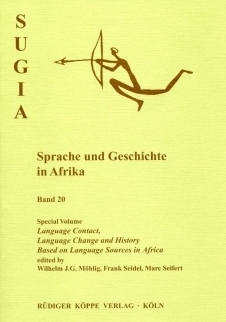


CONTENTS
Preface
Wilhelm J.G. Möhlig / Frank Seidel / Marc Seifert: Language Contact, Language Change and History Based on Language Sources in Africa
Roger Blench: Was there an Interchange between Cushitic Pastoralists and Khoesan Speakers in the Prehistory of Southern Africa and how Can this be Detected?
Koen Bostoen: Semantic Vagueness and Cross-linguistic Lexical Fragmentation in Bantu – Impeding Factors for Linguistic Palaeontology
Inge Brinkman: Writing, Oral Traditions and the Construction of Ethnic Identities
Gerrit J. Dimmendaal: Esoterogeny and Localist Strategies in a Nuba Mountain Community
Axel Fleisch: Language History in SE Angola – The Ngangela-Nyemba Dialect Cluster
Wilfrid H.G. Haacke: Crossing the Linguistic Divide between Namibian Khoekhoe and Kalahari Khoe – Possible Directions for Future Research
Eileen Kose: A Sketch of Pre-Colonial Metalworking in Northern Namibia and Southern Angola
Wilhelm J.G. Möhlig: Historiography on the Basis of Contemporary Linguistic Data – The Herero Case
Robert Nicolaï: Language Contact, Areality, and History – The Songhay Question Revisited
Henning Schreiber: Social Networks, Linguistic Variation and Micro Change in an African Context – A Case Study in the Borderland of Mali and Burkina Faso
Frank Seidel: Layered Language Genesis in the ‘Catch Basin’ of the Linyanti and Okavango Swamps – The Case of Yeyi
Marc Seifert: Folktales as a Source for Historical Traces – The Reintroduction of Iron Working along the Central Kavango
Anne Storch: Cultured Contact – Ritualisation and Semantics in Jukun
General Bibliography
Index of Languages and Subjects
Under these links you will find publications by the contributors and further studies of language contact in various African language families:
Language Contact, Language Change and History Based on Language Sources in Africa provides a significant contribution to linguistic historiography of Africa. First of all, however, the publication makes a thorough overview of the results of diachronic linguistics in the area of African studies and gives them a new dimension. If focuses on explaining contact phenomena and linking them to historical events on the continent. The contributors give the evidence to the idea that contact scenarios, not the reconstruction of protolanguage, are main goal of linguistic studies oriented at tracing the history of the people speaking these languages.
Nina Pawlak in Studies of the Department of African Languages and Cultures, 44/2010, 110-115
Readers who are specifically interested in southern Africa and its complex ethnolinguistic setting will get a number of new insights into “a multi-layered sociolinguistic situation with shifting ethnic identities, and contact situations that involve speakers with repertoires consisting of several languages (Bantu, Khoisan)” [...]
I can and would like to highly recommend this exciting collection of sophisticated case studies. These do not only give new insights into the complexities of language change and contact influences in southern Africa and beyond, they also expand the application of methods of comparative linguistics to the inclusion of extra-linguistic evidence and sociolinguistic facts and factors.
Gabriele Sommer in Journal of African Languages and Linguistics, 32/2, 2011, 307-308
© 2026 by Rüdiger Köppe Verlag – www.koeppe.de